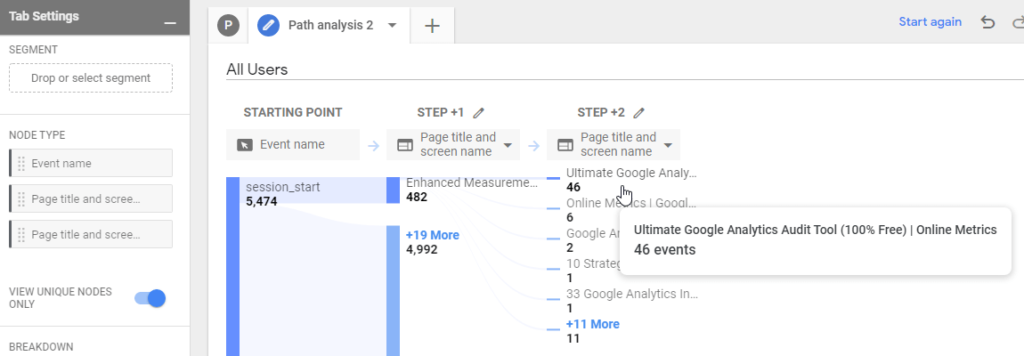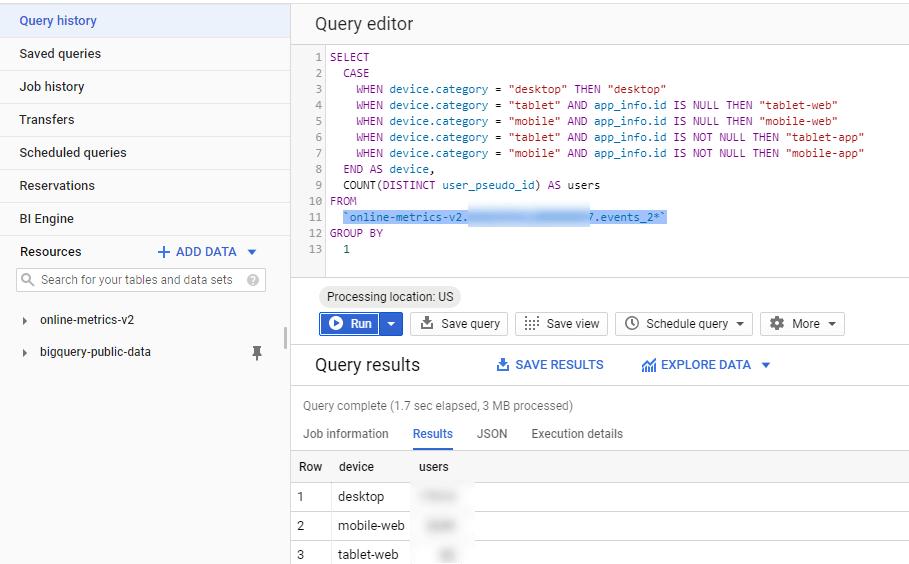Google Analytics Showdown: 22 Differences Between GA4 & Universal Analytics

Get acquainted with the most recent version of Google Analytics, the Google Analytics 4. Initially branded as Google Analytics App + Web, this new release brings a host of exciting features and enhancements that widely diverge from its 2013 predecessor. Curious about the updates in this fourth installment and how it varies from what you’re accustomed to? Stick around as we delve deeper into what this release offers.
1. Instead of an event’s numerical measurements
In the era of Universal Analytics, measurements such as page views and sessions took center stage. However, by the year 2020, user actions had also started gaining immense importance as a pivotal benchmark.

In the enhanced data model, every interaction is allocated to the segment of events. Each event might be constituted of a cap limit of 25 tailored indicators (metrics). These tailor-made metrics offer the potential of being utilized for prospective reports.
2. Consolidated data streams instead of separate ones for sites and applications
The configuration of Google Analytics 4 provides a feature for multiple data stream integrations for applications. It is here that you can contribute data streams for both the Apps alone and the combined Apps and Web alternatives. A standard perspective is auto-created for the Web resource, taking the place of data streams.

3. New analytics code format
The previously-known UA-XXXXXXX code structure has undergone an update and is now presented as G-XXXXXXXXXX.

4. Default IP Anonymization
The process of IP address encryption in Google Analytics 4 involves two particular actions: the use of a JavaScript tag, followed by a specific data collection network. This feature wasn’t absent in Universal Analytics. However, it was a function that required manual activation. The preservation of online security and ensuring the privacy of users should always be a top priority. Hence, it is crucial to understand how these steps for encryption work for smooth and safe operation.

5. Two cookies for tracking conversions instead of one
In the latest version of Analytics, we witness the introduction of 2 kinds of cookies: “_ga” and “_ga_XXXXXX”. Each cookie has a durability lasting for a time frame of up to 2 years, and they both get updated each instance data is dispatched to Google Analytics.

The initial cookie, dubbed as the “_ga” file, resembles its predecessor in Google’s Universal Analytics since it reserves a bespoke ClientID within its programming.

The consequent cookie comes in the “_ga_XXXXXX” configuration and has its primary use designated for the function of Measurement ID.

6. More default metrics
The updated version has efficiently broadened its catalogue of fundamental metrics. Freshly added metrics take into account:
- Page views (includes an option to disregard views that get based on browser history record).
- Scrolling events on the page.
- Clicks on web links integrated into the website that navigate the user away from your specified domain.
- Searching conducted on the site. This metric also has supplementary settings for advanced metrics tracking.
- Observations, scrolling actions, and several other engaging activities with a video embedded on the site.
- Uploading of various file types, which includes documents, applications, video, and audio files.

7. Page views are now events too
The scope of events considered has been greatly expanded in the latest version of web analytics. Previously, webpage views weren’t reckoned as events in the Universal Analytics system. However, this fresh perspective now includes them. Additionally, these events have undergone a structural makeover, relying extensively on the adjustments of custom parameters. This enhances the depth of data interpretation and subsequent actions based on user behaviors.

8. New Methods for Tracking Engagement
Traditional engagement measuring strategies that revolve around calculating time spent on the website, total page views, and measuring bounce rates are no longer considered efficient in contemporary Analytics. Now, it’s all about a more thorough and detailed approach. A user’s session gets the label “active” when it extends beyond 10 seconds. If this session is cut short by the user leaving the site or application, it is categorized as a opt-out. Hence, the assessment of user engagement ensues from the total number of such single-user active sessions. The duration of engagement is explicitly equivalent to the effective time the user spends on the website or within the application. To put it differently, periods when the device goes into sleep mode during an ongoing session aren’t factored in.
9. Full data instead of sampling
Confronted with a massive volume of data, Universal Analytics would formerly utilize just a portion of this data for producing reports. This approach primarily intended to ease the burden on servers and the underlying system. However, it also meant that the clients ended up receiving reports with some degree of inaccuracy. For example, the sample sessions were limited to 500K in case of Analytics Standard, and 100M for Analytics 360.
With the introduction of the revamped Analytics, reports are now generated without any sampling. This signifies a sizable shift in how data reporting is done, promising more precision.
10. Data storage limit
In contrast to Universal Analytics, which permits data requests for any time range in the past, the updated version imposes certain limitations. Specifically, it grants the ability to define the data retention duration for either a 2-month or 14-month period.


11. Remarketing Lists and Forecasts
Following the integration of your newly created analytics account with your Google Ads, you will gain the ability to utilize audiences in two distinctive ways.
Primarily, audiences are commonly leveraged as remarketing lists, enabling businesses to re-engage with visitors who have shown interest in their products or services.
Secondarily, they are impressively capable of forecasting two crucial probabilities – one is the prospect of a visitor converting into a customer and making a purchase, and the other is the likelihood of users opting not to revisit your website or application in the times to come.
Both of these critical probabilities are estimated with the aid of unique predictive metrics, offering you valuable insights to optimize your marketing strategies and decision-making process.
12. Additional data instead of special indicators
Perhaps it was due to a lack of interest or some other unknown reason, but the team behind Google Analytics made a decision to eliminate the feature designed to work with special indicators. These were utilized for recording numeric data unique to a particular user, something not typically captured by the default system. For instance, the ratio of visitors who engage in reading reviews and so on. However, within the revamped App + Web analytics tool, users now have the opportunity to implement an “advanced metrics” event category and customize their parameters.

13. User features in place of custom parameters
To effectively operate within customizable settings, it’s necessary to navigate to the “settings” tab found in Google Analytics 4. This will enable you to initiate trackings through the use of Google Tag Manager. The execution of this process will typically require the skills and involvement of a programmer who is adept at JavaScript. It’s worth noting that the upper limit for custom properties extends to a count of 25.

14. Views and View Filters
Google Analytics deploys Views as a crucial segment of its account setup. In the architectural outline of a pyramid, they find their place at the foundation. However, in the upgraded version, users no longer enjoy the privilege of altering views as previously available. Now, the focus has turned towards manipulating data streams and audiences.

Correspondingly, there has been an abolishment of view filters. Now, it’s feasible to develop regular filters within the realm of analytic reports.

15. Regular Expressions
In Universal Analytics, regular expressions were readily available and could be utilized in any context. However, in App + Web, the use of regular expressions is restricted to report tables. Additionally, they can be harnessed for the fabrication of new audiences.

16. Fewer standard reports
The configuration of updated Analytics reports has also been modified. Currently, the service provides four alternatives for a conventional report: individuals, demographic details, user activity, and technological background.

17. New features instead of custom reports
Now, it’s completely feasible to gather extensive data regarding the visitors to your website or application with the complimentary feature, Analyze. Further adding to the utility is the introduction of Google BigQuery, a cloud storage solution that’s available free of charge.

18. Funnel analysis is now free
In the past, the feature of funnels was exclusive to the premium version of Google Analytics 360. However, they are now accessible to every user. To find them, navigate through Explore > Analysis > Funnel Analysis.

19. Analyses on the intersection of segments is also free
Previously, just like with sales funnels, comprehensive segment analysis necessitated the acquisition of Google Analytics 360. This unique tool’s major strength lies in its ability to visually illustrate the connection among user groups. The tool enables you not only to benchmark various groups, but also categorize them based on specific parameters, and subsequently engineer new target audiences rooted in this valuable insight.

20. The ability to analyze a users ‘path’
Google Analytics 360 has brought forth yet another significant feature. This feature enables you to gauge visitor traffic to your website or application. The investigative function allows you to trace a visitor’s journey from the initial point (or the onset of their path) up to the final destination.

Leveraging this tool allows for a more comprehensive understanding of your entire user base, including specific segments. You have the ability to classify each step taken by a user as an event or a view, offering you granular control. As many as 10 steps can be embedded, after which, all accessible paths will be laid out for viewing.

21. A New path to user statistics
The availability of this report isn’t new; it existed in the preceding version of Analytics as well. However, the navigation path to it in Google Analytics 4 has slightly changed, and now it is: Explore > Analysis > User Explorer. The report has been revamped and shifted its focus from sessions to emphasizing more on the user’s perspective and the related events.

22. New integrations
The recent introduction of Analytics 4 has brought about numerous complimentary integrations, while BigQuery has expanded the range of possibilities for data scrutiny. However, utilizing these features entails an additional layer of knowledge. Looking ahead, there is an impending plan to amalgamate with Search Console, Display & Video 360, and Search Ads 360.

Slowly but surely, Google Analytics 4 is ushering in a whole new era of deep data inspection by making it more attainable with gratuitous tools. The landscape of web analytics has evolved to be intricately labyrinthine and slightly more complex. Transitioning to the latest version is still an option and eventually, certain features may need to be temporarily withheld. During this intermission, it’s an opportunity to accustom oneself to this innovative product.
- 1. Instead of an event's numerical measurements
- 2. Consolidated data streams instead of separate ones for sites and applications
- 3. New analytics code format
- 4. Default IP Anonymization
- 5. Two cookies for tracking conversions instead of one
- 6. More default metrics
- 7. Page views are now events too
- 8. New Methods for Tracking Engagement
- 9. Full data instead of sampling
- 10. Data storage limit
- 11. Remarketing Lists and Forecasts
- 12. Additional data instead of special indicators
- 13. User features in place of custom parameters
- 14. Views and View Filters
- 15. Regular Expressions
- 16. Fewer standard reports
- 17. New features instead of custom reports
- 18. Funnel analysis is now free
- 19. Analyses on the intersection of segments is also free
- 20. The ability to analyze a users 'path'
- 21. A New path to user statistics
- 22. New integrations
Contact Me


